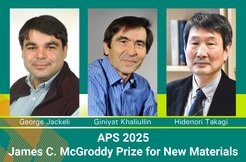2025 James C. McGroddy Prize awarded to George Jackeli, Giniyat Khaliullin, and Hidenori Takagi
George Jackeli, Giniyat Khaliullin, and Hidenori Takagi, all from the Max Planck Institute for Solid State Research, have been selected for the American Physical Society’s prestigious 2025 James C. McGroddy Prize for New Materials,

“For seminal theoretical and experimental research, materials design and discoveries that pioneered the exploration of novel forms of topological quantum matter in spin-orbit assisted Mott insulators realized in transition metal oxides.”
The James C. McGroddy Prize for New Materials was established in 1997 and is awarded annually to scientists to recognize their outstanding achievements in “the discovery of new classes of materials, the observation of novel phenomena in known materials leading to both fundamentally new applications and scientific insights, and shall include theoretical and experimental work contributing significantly to the understanding of such phenomena” [1]. The award will be presented at a ceremony in March 2025.
George Jackeli, Giniyat Khaliullin, and Hidenori Takagi have played pioneering roles in the prediction and realization of exotic electronic phases in 4d and 5d transition metal oxides, where strong spin-orbit coupling meets electronic correlations. Early interest in this field was sparked by the discoveries of a quantum spin liquid (QSL) in the hyper-kagome compound Na4Ir3O8 [2] and a spin-orbital Jeff = 1/2 Mott insulator in Sr2IrO4 [3], for which Hidenori Takagi and his team made significant contributions. George Jackeli and Giniyat Khaliullin theoretically described spin-orbital entangled states and made a bold prediction that the Jeff = 1/2 state on a honeycomb lattice could realize the elusive Kitaev model [4]. The Kitaev model has an exactly solvable QSL state with fractionalized Majorana excitations, proposed to be a possible platform for topological quantum computation. George Jackeli and Giniyat Khaliullin’s prediction set off a frantic race to materialize the Kitaev QSL in 4d and 5d transition metal compounds. Among the best Kitaev candidate materials are the hyper-honeycomb compound b-Li2IrO3 [5] and H3LiIr2O6 [6], both discovered in the group of Hidenori Takagi, the latter of which has a spin-orbital entangled QSL ground state. More recently, George Jackeli, Giniyat Khaliullin, and Hidenori Takagi have continued to lead the way with explorations of other spin-orbital entangled phases [7–10], extension of the Kitaev QSL to 3d transition metal oxides [11], and clarification of unusual thermal transport properties and observation of a 2D quantum critical Bose gas in Kitaev honeycomb candidates [12,13].
Congratulations to all three for their well-deserved recognition!
References:
[1] https://www.aps.org/funding-recognition/prize/james-mcgroddy
[2] Okamoto, Takagi et al., Phys. Rev. Lett. 99, 137207 (2007).
[3] Kim, Takagi et al., Science 323, 1329 (2009).
[4] Jackeli and Khaliullin, Phys. Rev. Lett. 102, 017205 (2009).
[5] Takayama, Takagi et al., Phys. Rev. Lett. 114, 077202 (2015).
[6] Kitagawam, Jackeli, Takagi et al., Nature 554, 341 (2018).
FKF highlight: https://www.fkf.mpg.de/6288872/2018_02_Takagi
[7] Romhányi, Jackeli et al., Phys. Rev. Lett. 118, 217202 (2017).
[8] Khaliullin, Phys. Rev. Lett. 111, 197201 (2013).
[9] Takahashi, Khaliullin, Takagi et al., Phys. Rev. Lett. 127, 227201 (2021).
[10] For reviews, see Takagi et al., Nature Review Physics 1, 264 (2019) and Takayama et al., J. Phys. Soc. Jpn. 90, 062001 (2021).
[11] Liu, Khaliullin et al., Phys. Rev. Lett. 125, 047201 (2020).
[12] Bruin,Takagi et al., Nat. Phys. 18, 401 (2022) and Bruin et al., APL Mater. 10, 090703 (2022).
FKF highlight: https://www.fkf.mpg.de/7702799/2022_02_Bruin
[13] Matsumoto, Jackeli et al., Nat. Phys. 20, 1131 (2024).
FKF highlight: https://www.fkf.mpg.de/8274799/2024_05_Matsumoto












